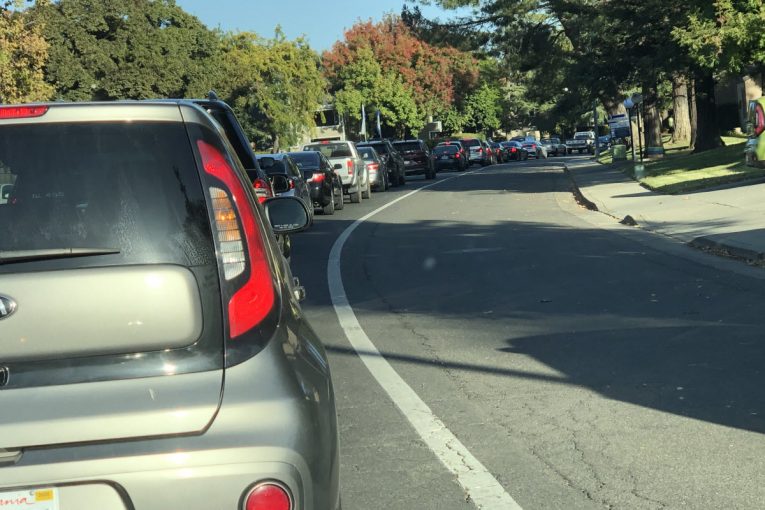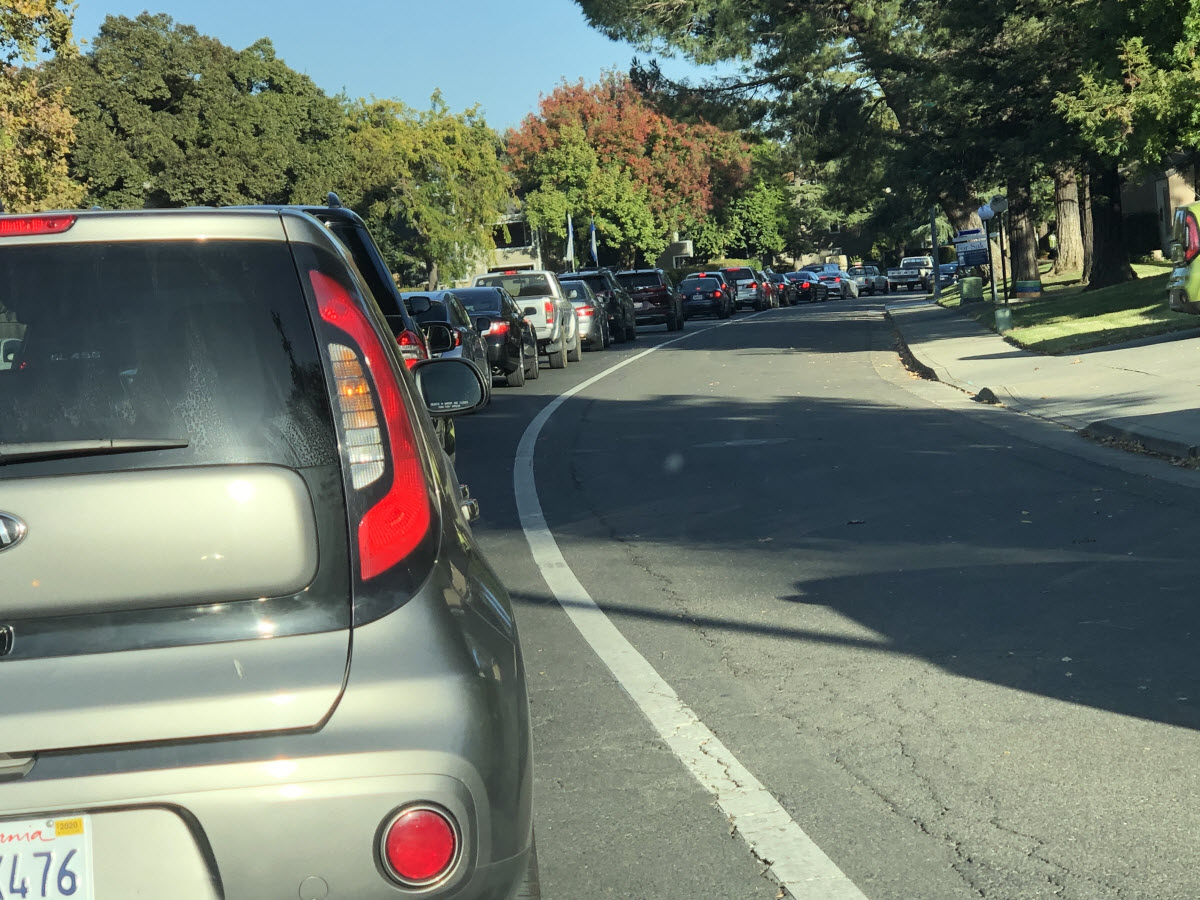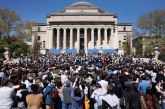

It was a week ago that about 200 people met at Pioneer Elementary and consultants from Fehr & Peers gave us the data which really suggests that very little that we do will fix Mace Boulevard until I-80 is fixed.
The public in attendance on Thursday of last week definitely had a single solution in mind – change Mace back to the way it was. The problem is that as Fehr & Peers consultant Adrian Engel pointed out, fixing Mace means encouraging more cars to bypass I-80 on Tremont in Dixon – which will simple add to the congestion.
Most people at the meeting didn’t want to hear that. They have convinced themselves that the problems began when the city redesigned Mace. They forget that the same problems existed in the winter of 2017, well before the city did any construction on Mace.
Let’s walk through component parts of the corridor.
First of all, most of the time the corridor is relative free flowing. The problem times are Thursday and Friday late afternoons to evenings. That’s when the traffic on I-80 comes to a stop, and when the maximum flow of traffic – estimated at roughly 200 cars per hour bypassing I-80 in hopes of saving ten minutes (the Enterprise article suggested it was one minute of savings, and perhaps at the time they looked it was, but Mr. Engel suggested it was ten based on their analysis).
Second, let’s look at southbound Mace from Harper Junior High to the I-80 on-ramp. To me this is the critical tell that the problem isn’t construction on Mace, but rather I-80. Why? There is no construction on this part of Mace. The traffic backs up to the on-ramp and once you get past the freeway entrance there is no congestion.
Eastbound Chiles at the intersection of Mace: There is a back up along the Chiles frontage road. The cause of that back up – traffic that was attempting to turn left at Mace and onto the freeway. Because of the backup on the on-ramp and the queue, that traffic backs up onto Chiles. A few cars can turn at a time, and impatient turning vehicles will block the intersection. The other week I saw a big rig do that and block half the intersection for a full cycle. A police office ended up talking to the driver. While frustrating, none of that is due to construction on Mace, as it is all  well to the north of the construction.
well to the north of the construction.
Westbound Chiles at Mace: There isn’t a huge amount of traffic here. The big problem, though, is the backup from the on-ramp will block right turns for vehicles not attempting to turn onto the freeway, and there is a mild back up for vehicles that are attempting to turn onto the freeway.
Eastbound Cowell: Two weeks ago it took about 20 minutes to get from Drummond past Mace going straight, as opposed to turning onto Mace. Last week the traffic flow was fairly clear until the immediate intersection. The difference, apparently, was that there was a vehicle collision two weeks ago that caused a massive back up on the whole system. Last week there was not. The good news here is that cars have lined the left turn, lane allowing through traffic to get through. The left turn back up is exclusively caused by back up of traffic getting on the freeway and is completely unimpacted by redesign.
Westbound Cowell: Here is the first of these components that is impacted by the redesign. There is a backup here for traffic attempting to turn right and get on the freeway. With the redesign, there is no longer a separate turn lane – which means that traffic wishing to continue onto westbound Cowell is caught up in the traffic attempting to turn north on Mace and onto the freeway. It’s not a ridiculous back up, but it is causing a delay for local traffic.
Northbound Mace south of Cowell: Here is what is happening. The single lane is preventing vehicles wishing to continue north on Mace to get caught up in the delay. That means if you are going to Nugget or Target rather than eastbound I-80, you are stuck until you get past Cowell – at which point, you simply get into the left lane and are free and clear.
Can they fix that part of it? The consultants are talking about restoring that area to two lanes. But there is risk there. Can you convince vehicles to stay in the right lane, or will there be a temptation to jump the queue, and then cut over causing the entire roadway to back up?
We can probably look at the other direction as a guide. What we see going southbound is, if the traffic back up is moderate, through traffic can go in the left lane and largely bypass the queue. However, once the traffic reaches a critical mass, traffic attempts to bypass the queue and then cut back over at the end, which leads to the back up in both lanes.
Our guess, therefore, is that when traffic gets bad enough, both lanes are going to be blocked and there will be no way to bypass it.
Engineers are therefore looking at a few fixes. First, they want to add signals along the corridor to better meter and space the traffic. Second, they do want to add back the lanes taken away.
Mr. Engel noted this will “allow some of the local traffic to bypass the queue to be able to get around some of the traffic.”
The problem again, by creating additional capacity, is “it could induce people to leave 80 at Dixon and drive into this community.”
He warned that could mean, instead of 200 cars, there could be 400 cars because I-80 hasn’t gotten better yet and there would be additional capacity on this road.
Finally he suggested adding ramp meters to the HOV (high occupancy vehicle) bypass lane at the freeway on-ramp. Right now, he said half of the cars jump over to the HOV lane to bypass the traffic signal because they’ve been sitting on Mace for 35 minutes and calculate it is unlikely they will be caught and ticketed.
In general, while I think they can improve Mace south of Cowell a bit, most of the problems are not caused by the redesign and are instead caused by the increased volume of traffic on I-80 – and until they address that, things really aren’t going to get better.
—-David M. Greenwald reporting







Aside from cut through traffic from eastbound I80, who else is using Tremont?
Has anyone considered scheduled closure of Tremont at a point between I80 and Mace during 2 hr commute window?
What other methods could be employed to discourage cut through traffic?
Additional traffic controls (stop signs) at intersections along Tremont?
Daytime DUI checkpoints?
Ca Bureau of Automotive Repair Roadside Smog Inspections on Tremont?
https://www.bar.ca.gov/consumer/roadside_inspection_program.aspx
Maximum traffic enforcement along Tremont and south Mace Blvd. in Yolo County by CHP funded by Regulate Aggressive Driving and Reduce Speed (RADARS) III grant.
Im just thinking of ways to disencentivize cut through traffic.
I suggest a stop light signal on Tremont as it dead-ends into Mace for 2 hours each evening with signal delays exceeding the additional time gained by end-running I-8o with WAZE. So if WAZE predicts 10 minutes saved by jumping off at Midway west of Dixon and then connecting to Mace through Tremont, then have a 15 minute signal holding traffic back that long at Tremont and Mace. WAZE would immediately take that detour down from their app as there would be no time saved and would even have time added.
Of course, this is on County roads so the County would have to install the signal and a camera to catch and ticket signal jumping violators of which there would be many even if there was a big sign stating the camera would result in $250 tickets to signal jumpers. But this traffic ticket revenue could make the signal installation revenue neutral or even positive for the County.
This is a simple solution that would not adversely impact the companies (and wealthy homeowners) south of Davis on Mace. El Macero is in the County and Provenza’s district so they should get together and work with Provenza to make this happen. This is the easiest and quickest fix available to shut down bypass traffic on Tremont. I acknowledge this was not my idea and it raised my eyebrows when I first hear it sugested but on reflection I realized it is the cheapest and most effective fix available. Our Council should work with the County in the 2x2s to make it happen.
I am assuming it wouldn’t be legal to have that long a light, but the city and county might be able to negotiate something with Solano County regarding access to Tremont and Mace.
Just confirmed that it is not legal – re: the long light. Provenza and Saylor have a meeting set with Solano however.
Solano Co staff, or electeds? Big diff… [your 11:28 post]
You are correct as to easily challenged/illegal signal timing…
Do you have a legal cite? How did you confirm the illegality of a long light?
I asked the police chief
And, David, re: unjustified signal timing, I affirm what Chief Pytel told you… no registered engineer, entitled to practice traffic engineering, would even harbor the thought for more than 0.25 seconds… just a
stupidill-conceived idea…This afternoon east-bound 1st Street was stopped with a line of cars from the Richards under-crossing all the way back to B Street. And south-bound B Street was solid with stopped cars all the way up to 5th Street. All of this waiting to get onto the freeway.
Gosh, that Mace redesign sure had far-reaching impacts!
I’m sure that’ll be blamed on not widening The Keyhole, within the hour.
Yes. Our elected officials need to put pressure on CalTrans to expedite the widening of the Causeway. City council, county supervisors, assembly member and state senator all need to engage the Newsom administration on this.
That will not solve the issue… just move it.
The real problem is SOV’s, driver behavior (cutting and weaving, timing of trips)… a very expensive ‘failure’ to resolve a ‘problem’…
Oh… if the causeway is widened, expect more ‘horrendous’ delays during construction… 99.5% guaranteed… nature of the beast…
When traffic is backing up at the causeway every day for a couple of miles, for a couple of hours, that is a problem that needs to be solved by a plan that is already in process. It just needs to be expedited.
The real problem is the freeway narrowing down in that spot, so it is insufficient for the number of vehicles that are passing through every day. When they get to the other side, vehicles go off in multiple directions and the problem is largely solved from that point on. This is really simple, CalTrans already has a plan for it. They just need to get going on it.
Don… the freeway doesn’t narrow down, e-bound, at the causeway… it happens just before Richards… w-bound, might help until one gets to Swingle… then…
SOV’s, driver behavior are the main problems as to capacity (nearly 10 P… are there any issues?)… I stand by that… for two-four hours of inconvenience/frustration, what should everyone pay for? Really…
Think of the carbon impact to produce/transport the materials, do the construction for a widening… to no real material effect… think. Cogitate.
Here is what is proposed: http://yoloagenda.yolocounty.org:8085/docs/2017/BOS/20171024_1765/6872_32%20-%20Yolo%2080%20Bus-Carpool%20Lane%20.pdf
It addresses the SOV issue and improves bike and pedestrian access as well. It’s already in process. It just needs to be expedited.
I have no idea what this means.
Bill points out that this is not accurate:
“The real problem is the freeway narrowing down in that spot,”
Which spot? Surely not at the causeway EB? The three lanes EB through Davis continue across the causeway as three lanes. A big issue is the huge bubble that has been created by the 113 and Old Davis merges onto EB 80. And that won’t be solved by adding a lane to the causeway. I’m willing to commit resources to fixing that bubble.
Notice that right here, the freeway is briefly seven lanes wide in the EB direction. It then sheds those lanes back down to three before the Richard’s exit. It remains three lanes through Davis and clear across the causeway. It may seem counter-intuitive, but those extra lanes are a big part of the congestion problem.
https://tinyurl.com/y4kdmzkk
In as much as adding another lane to the causeway would “add capacity” to the freeway, the resultant induced demand would swallow up any vehicle throughput benefit almost instantly. There are hundreds of recent examples of this in California alone. Spend billions and end up with more lanes of stopped traffic. What indication do you have that adding a lane to the causeway will solve the congestion? I mean besides the idea that “more lanes are better for traffic” concept.
The evidence is in the link I provided. See pages 4 and 9.
http://yoloagenda.yolocounty.org:8085/docs/2017/BOS/20171024_1765/6872_32%20-%20Yolo%2080%20Bus-Carpool%20Lane%20.pdf
Pretty simple math in that report. Even if we take their optimistic projections at face value (caveat: NEVER take optimistic projections from traffic engineers at face value!):
The “50% decrease in Average Delay – Seconds (EB) PM Peak Period & 38% decrease in Average Delay – Seconds (WB) PM Peak Period” are for “Bus/Carpool Lane benefits compared to 2035 no build scenario.”
The baseline “no build scenario shows “97% increase in Average Delay (EB) PM Peak Period & 288% increase in Average Delay (WB) PM Peak Period”
So the improvements end up with a projected 48.5% increase in average delay EB and a 109.5% increase in average delay WB by 2035.
And that’s before considering the real phenomenon of “induced demand” from increased capacity.
The problems are going to get way worse even with the projected “improvements”.
Man you guys are quick! Rik beat me to it.
(might be “simple math” but there are precious few who understand what those prediction mean and how they relate)
The positive-sounding “delay decreases” shown in the build scenario are merely the lessening of the projected *increases* of the no-build scenario. The projection is that the delays will not be less than they are today. The slides you point to tell us that the build scenario will be an increase of delay of approximately 50% and 100% as compared to today.
And that comes from their rosy predictions. Does it still sound like a good way to spend billions?
Yes. It will be much worse if we don’t. That is a very simple concept to most people who use that freeway.
CalTrans has a reasonable plan. They are working to enhance use of multiple-occupancy vehicles and make bike commuting to Sacramento easier while also providing relief from increased congestion for auto drivers. The argument that “it’s going to get worse anyway, so don’t try to make it less worse” doesn’t exactly resonate.
Don Shor: you were saying that these improvements would “solve” the congestion. You were completely wrong about that.
What is remarkable about this comment is that Rik actually believes that his opinion is fact
Since the improvements are ‘prospective’ (not past, nor present), your ‘tenses’ are all over the place… as is your convenient “linking” to ARC.
Just saying… (if ARC doesn’t happen, no skin off my nose… if it happens, will not lose sleep…)… I can easily deal with either event…
Whatever…
Can “we” fix Mace? Probably not. Can”we” make it a lot worse? Most certainly! Especially if “we” advocate for a freeway-oriented, automobile-dependent business park right on the Mace curve—one that simultaneously adds a tremendous amount of parking (almost 5,000 spaces) and yet vastly undersizes its parking needs compared to industry and regional standards for such developments.